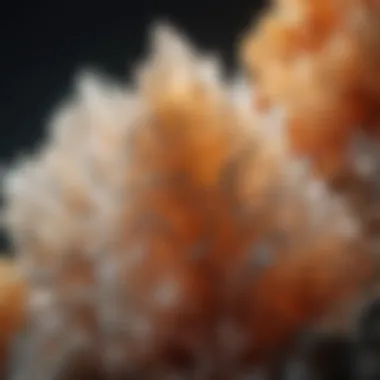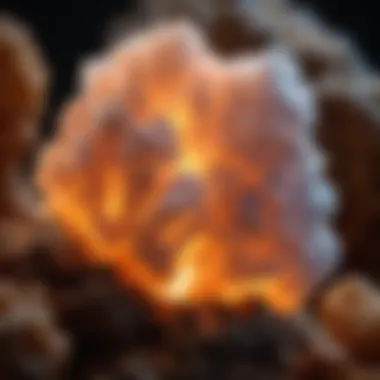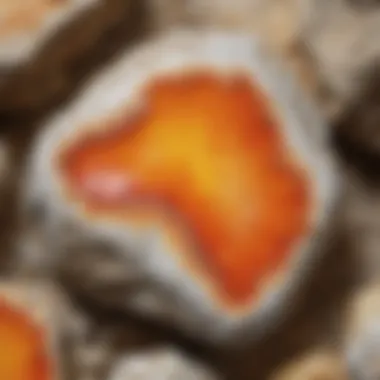Discover the Fascinating World of Calcite: A Collector's Guide Near You


Rock and Fossil Identification
In the realm of rock and fossil collecting, one of the most intriguing minerals to seek out is calcite. Recognizable for its distinctive crystal structure and vibrant colors, calcite comes in various forms such as rhombohedrons, scalenohedrons, and dogtooth crystals. When identifying calcite specimens, collectors should pay close attention to key characteristics like its double refraction property, effervescence in contact with acids, and varied crystal habits. Utilizing tools like a hardness pick, a UV light, and a magnifying glass can aid in the accurate identification of calcite samples.
Collecting Tips and Techniques
For enthusiasts seeking to explore the world of calcite, mastering effective collecting techniques is paramount. It is essential to conduct thorough research to identify prime collecting sites rich in calcite deposits. Whether combing through limestone quarries, exploring caves, or venturing along riverbeds, understanding the geological context of calcite formation can greatly enhance the chances of unearthing high-quality specimens. When extracting calcite samples, employing gentle techniques and utilizing appropriate tools, such as chisels and brushes, is crucial to minimize damage and ensure the specimens are carefully removed from their surroundings.
Preservation and Display
Preserving and showcasing calcite specimens require meticulous attention to detail and care. To maintain the integrity of the specimens, collectors can employ techniques like cleaning with a soft brush and mild soap, avoiding exposure to harsh chemicals that may alter the mineral's appearance. When it comes to storage, storing calcite in a dry, cool environment can prevent deterioration and preserve the specimen's unique features. For creative display ideas, incorporating lighting elements to highlight calcite's fluorescence or arranging specimens in a shadow box can create visually striking displays that showcase the beauty of these geological marvels.
Geological Insights
Delving into the geological aspects of calcite sheds light on its fascinating formation and historical significance. Understanding the various geological formations where calcite can be found, such as limestone caves, hydrothermal veins, and sedimentary deposits, provides valuable insights into the mineral's origins and characteristics. Exploring the historical significance of calcite reveals its use in ancient civilizations for decorative purposes, as well as its role in modern industry for producing lime and cement. Notable discoveries in the field of calcite research further enrich the understanding of this versatile mineral and its importance in the world of geology and mineralogy.
Introduction to Calcite
Calcite, a fascinating mineral abundant in nature, plays a crucial role in the world of rock and fossil collecting. Understanding the significance of calcite serves as a foundational aspect for enthusiasts eager to explore and appreciate this mineral further. In this section, we delve into the origins of calcite, its unique properties, and its relevance to the field of geology and mineralogy.
Formation of Calcite
Calcite's formation is a captivating process that involves various intricate elements. The chemical composition of calcite is predominantly composed of calcium carbonate, making it a standout mineral in geological formations. Its distinct crystal structure and formation through geological processes over millennia contribute to its allure and appeal to collectors and researchers alike.


Chemical Composition of Calcite
The chemical composition of calcite, primarily comprising calcium carbonate, imbues it with remarkable properties. Its composition plays a vital role in determining the mineral's characteristics, such as its color variations, transparency levels, and luster. Understanding the chemical makeup of calcite is essential for appreciating its diverse forms and structures.
Geological Processes
The geological processes involved in the formation of calcite are intricate and fascinating. From sedimentary to metamorphic processes, calcite's journey in the earth's crust showcases the dynamic nature of mineral formations. Exploring the geological processes responsible for calcite deposition provides valuable insights into its history and distribution.
Crystal Structure
The crystal structure of calcite, known for its rhombohedral shape, defines its unique aesthetic appeal and physical properties. The arrangement of atoms within its crystal lattice influences its transparency, cleavage, and other optical properties. Delving into the crystal structure of calcite unveils its intricate beauty and scientific significance.
Physical Properties of Calcite
Calcite's physical properties offer a wealth of information for collectors and researchers examining this mineral. From its rich color variations to distinctive transparency levels and luster, calcite showcases a spectrum of characteristics that make it a sought-after specimen in geological studies and collections.
Color Variations
The color variations exhibited by calcite range from pristine whites to vibrant yellows, oranges, greens, and blues. These variations often result from impurities present during crystal formation, adding depth and uniqueness to each specimen. Recognizing and appreciating the diverse color palette of calcite enhances the collector's experience and understanding of this mineral.
Transparency
Calcite's transparency levels vary depending on its crystal structure and the presence of inclusions or impurities. Some calcite specimens exhibit exceptional transparency, allowing light to pass through with stunning optical effects. Understanding the factors influencing calcite's transparency enhances the appreciation of its visual allure and geological significance.
Luster


The luster of calcite, ranging from vitreous to pearly or waxy, contributes to its overall aesthetic appeal and value. The interaction of light with calcite's surface reflects its internal structure and crystal habits, adding a captivating shimmer to each specimen. Exploring the diverse luster types of calcite enriches the collector's perception of this multifaceted mineral.
Locating Calcite Deposits
Locating calcite deposits plays a pivotal role in the realm of rock and fossil collection, as it is the gateway to uncovering these geological wonders. Understanding where and how to find calcite specimens can significantly enhance the collector's experience and yield rare finds. By delving into the specifics of calcite deposit locations, enthusiasts can enrich their collection with unique pieces from various geological formations and regions, adding value and diversity to their catalog.
Geological Regions Rich in Calcite
Key Locations Worldwide
Exploring key locations worldwide for calcite deposits provides collectors with unparalleled opportunities to encounter diverse forms and colors of calcite. From the captivating stalactites and stalagmites in caves to the shimmering gem-quality crystals in certain mines, these locations showcase the extensive geological diversity of calcite. Each key location offers a distinctive ambiance and geological context, making it an enticing choice for collectors looking to expand their knowledge and specimen collection. However, the accessibility and regulations surrounding these key locations can vary, impacting the ease of exploration and collection.
Local Geological Surveys
Local geological surveys serve as valuable resources for collectors aiming to pinpoint potential calcite deposits within their vicinity. These surveys offer detailed findings and insights into the geological composition of the region, highlighting areas where calcite formations are prevalent. By leveraging local geological surveys, collectors can streamline their search efforts and focus on areas with higher calcite concentration, increasing the likelihood of successful discoveries. However, the accuracy and comprehensiveness of these surveys can differ based on the scope and frequency of geological assessments conducted.
Online Resources
Online resources provide a digital gateway to a wealth of information on calcite deposits, offering collectors a virtual library of data, maps, and forums dedicated to rockhounding. These resources enable collectors to conduct remote research, access real-time updates on new discoveries, and engage with a global community of fellow enthusiasts. Additionally, online resources facilitate networking opportunities and knowledge-sharing, allowing collectors to stay informed about the latest trends and emerging locations for calcite collection. However, the credibility and reliability of online sources can vary, necessitating discernment when utilizing these platforms for information gathering.
Preserving Calcite Specimens
Preserving calcite specimens is a crucial aspect to consider for rock and fossil collectors, as it ensures the longevity and integrity of these geological treasures. The preservation process plays a significant role in maintaining the beauty and scientific value of calcite specimens for years to come. By properly preserving calcite specimens, collectors can protect them from external damage and deterioration, allowing for continued study and enjoyment.


Cleaning and Storage
Gentle Cleaning Methods:
Gentle cleaning methods are essential in the preservation of calcite specimens as they help remove dirt and debris without causing any harm to the delicate structures of the mineral. Utilizing mild cleaning solutions and soft brushes, collectors can gently clean calcite specimens to reveal their true beauty without causing any damage. This method is highly favored in this article due to its effectiveness in maintaining the specimen's natural characteristics while ensuring proper cleaning.
Proper Storage Conditions:
Proper storage conditions are vital in preserving calcite specimens as they help prevent any environmental factors from causing harm to the specimens. Storing calcite specimens in a cool, dry place away from direct sunlight and extreme temperatures is crucial to maintain their integrity. By following correct storage practices, collectors can ensure that their calcite specimens remain in pristine condition for years to come. The emphasis on proper storage conditions in this article highlights its importance in ensuring the longevity of calcite specimens.
Preventing Damage:
Preventing damage to calcite specimens is a fundamental aspect of preservation, as any harm incurred can greatly diminish the specimen's scientific and aesthetic value. Implementing careful handling techniques and using protective measures such as padding and cushioning during transportation can help prevent damage to calcite specimens. By prioritizing preventative measures, collectors can safeguard their specimens from accidents or mishandling, ultimately preserving their beauty and integrity. The focus on preventing damage within this article underscores its significance in maintaining the quality of calcite specimens.
Documentation and Labeling
Recording Collection Data:
Recording collection data is essential for rock and fossil collectors as it provides valuable information about where and when specimens were collected, their geological context, and any notable features. This data not only enhances the scientific value of the collection but also serves as a reference point for future studies and research. By meticulously recording collection data, collectors can create a comprehensive catalog of their specimens, enabling detailed analysis and interpretation. The emphasis on recording collection data in this article emphasizes its role in preserving the provenance and significance of calcite specimens.
Labeling Techniques:
Implementing proper labeling techniques is crucial in uniquely identifying and categorizing calcite specimens within a collection. By utilizing clear and concise labeling methods, collectors can organize their specimens effectively, making them easily accessible for study and display. Proper labeling also aids in creating a coherent collection that can be shared and studied by other enthusiasts and researchers. The integration of labeling techniques in this article highlights their importance in facilitating organization and communication within the collecting community.
Detailed Documentation:
Detailed documentation of calcite specimens is essential for creating a comprehensive record of each specimen's unique characteristics, locality information, and any special features. This detailed documentation serves as a valuable resource for researchers, educators, and fellow collectors, providing in-depth insights into the specimens and their geological significance. By documenting specimens thoroughly, collectors can contribute to the body of knowledge surrounding calcite and enrich the understanding of these captivating minerals. The emphasis on detailed documentation in this article underscores its significance in capturing the essence of calcite specimens for posterity.
Connecting with Local Collectors
In the realm of rock and fossil exploration, connecting with local collectors stands out as a pivotal element in enhancing one's experience and knowledge in the field. A vital component of \







